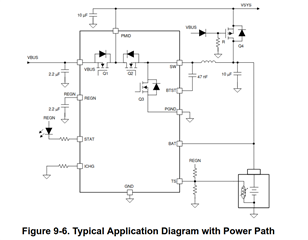Tool/software:
Hi
We are using the BQ25302 in a setup similar to the one in the datasheet:

The difference is that we are using REGN to switch Q4. Our charging current is 1A.
When we unplug the USB connector, VBUS and REGN go down to zero as expected when we have no additional load at VSYS. When we add 1A of additional external load at VSYS, VBUS and REGN change to battery voltage when the USB connector is unplugged. It seems that switching off Q1 does not work anymore and the battery keeps VBUS and therefore REGN alive through Q2 and Q1. And because REGN is still alive, Q4 is not switching and our circuit is not working as expected
We can reproduce that it is load dependent: The limit is somewhere around 0.9A - 1A (plus charging current of 1A).
Any idea what can cause this problem and how we can solve it?
Thank you!



